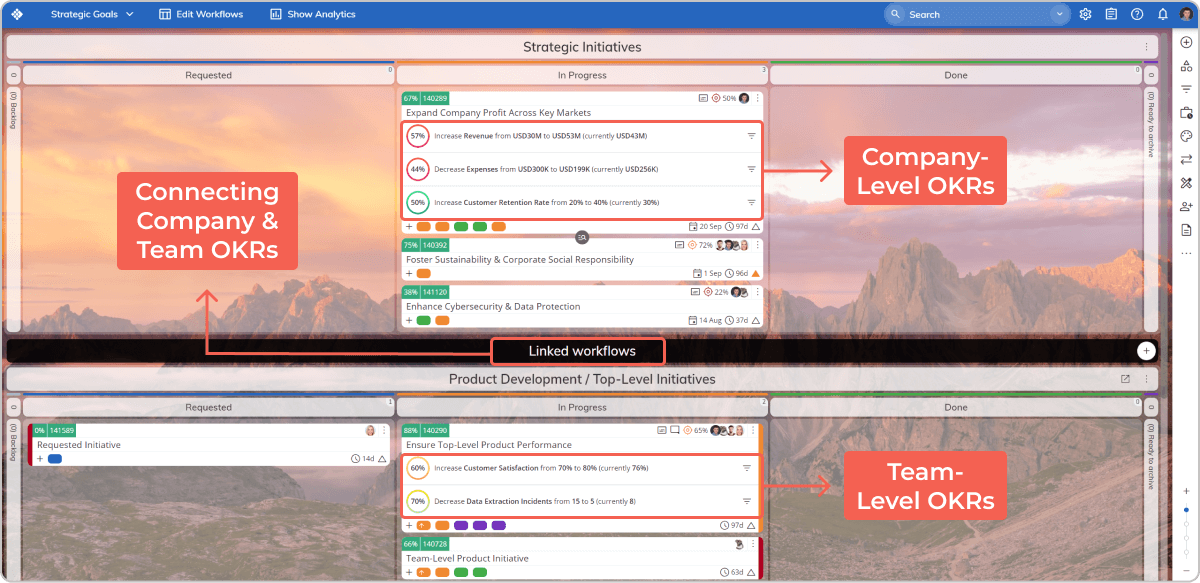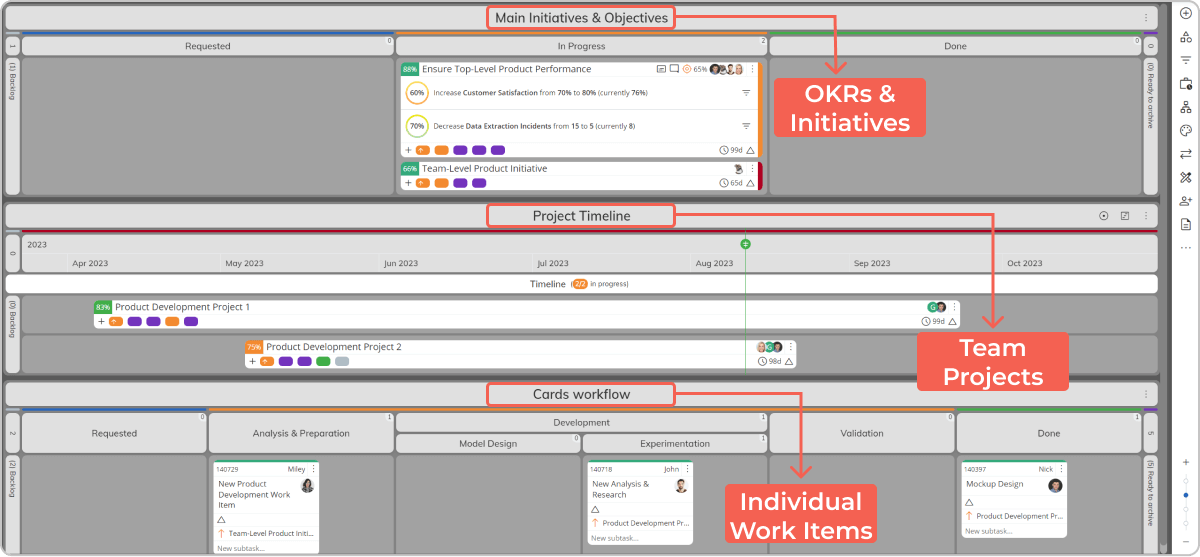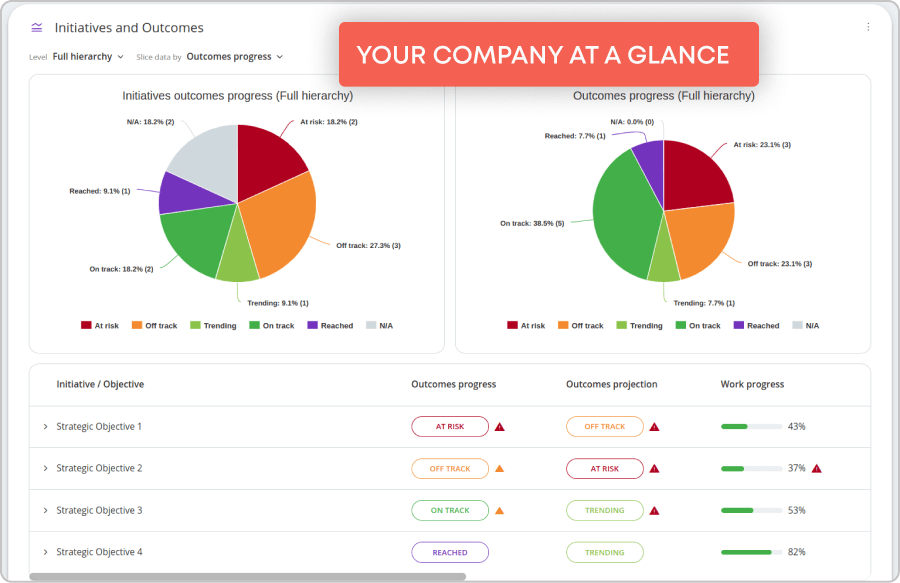Key Takeaways
- Why is strategy execution software necessary? Strategy execution software bridges the gap between planning and delivery, aligning goals with initiatives, tracking progress, and turning vision into measurable results.
- What challenges does it solve? It addresses misalignment between goals and work, lack of visibility into portfolios, and disconnects between strategy and workflows with real-time dashboards and workflow tracking.
- Who needs it most? C-level executives, PMOs, program and operations managers, and organizations undergoing digital or Lean transformations gain the most value from strategy execution platforms.
- What features should you look for? Core capabilities include OKR & KPI tracking, strategic roadmaps, portfolio management, cross-department linkage, automated reporting, forecasting, and continuous improvement tools.
- Best tool: Businessmap stands out for enterprise-ready execution, offering end-to-end visibility, OKR alignment, Portfolio Kanban, and real-time progress tracking to unify strategy and execution at scale.
What Is Strategy Execution Software?
Strategy execution software is a digital platform that connects strategic planning with operational execution. It enables companies to translate long-term goals into actionable initiatives and track progress in real-time.
What Are the Main Challenges Addressed by Strategy Execution Software
Whether you're a C-level executive, strategy leader, or team manager, the right strategy execution software transforms how you connect planning to action. Here's how:
1. Lack of Alignment Between Company Goals & Project Work
A powerful execution platform lets you define strategic goals and directly link them to supporting initiatives, projects, and team-level activities. For example, suppose your top-level objective is to expand your market presence. In that case, the software can help you break that down into supporting programs, like launching a regional campaign or improving customer onboarding, and connect them to specific teams and deliverables. This ensures that every action across the organization clearly contributes to the overarching goal.
2. Poor Visibility into Projects & Programs Across a Company's Portfolio
Program or portfolio managers must see the big picture without losing sight of the details. Strategy execution software provides a centralized portfolio view that shows how each initiative ties back to strategic priorities. For instance, if your organization is rolling out a digital transformation strategy, you can track all associated programs (like cloud migration or process automation) in one place. This helps prioritize resources, monitor progress, and ensure alignment across departments.
3. No Connection Between Strategy & Delivery Workflows
Execution tools with built-in workflow management capabilities let you visualize and monitor how work moves across teams. If a critical product development project stalls due to resource bottlenecks or cross-team dependencies, leaders are alerted immediately and can intervene before delays escalate. With real-time updates, dashboards, and performance metrics, you can track key initiatives' progress and ensure nothing falls through the cracks.
The Core Benefits of Strategy Execution Software
With 70% of strategic transformation plans failing, the gap between vision and delivery is real. Strategy execution platforms are often the missing piece of the puzzle that organizations need to align their vision, coordinate teams, track goals, and measure progress, turning plans into results.
- Strategic Alignment: Aligns company, department, and team goals with strategic objectives.
- Transparency: Offers a clear line of sight into work progress, dependencies, and performance.
- Agility: Enables organizations to adapt and pivot quickly based on real-time data.
- Accountability: Clarifies ownership and responsibilities for initiatives.
- Collaboration: Fosters cross-functional teamwork through centralized communication and updates.
- Decision Support: Delivers insights through analytics and visual dashboards to guide prioritization.
Who Needs Strategy Execution Software?
This type of software is most valuable for:
- C-level executives requiring visibility into strategic progress.
- PMOs managing complex portfolios.
- Program Managers aligning project work to company objectives.
- Operations Managers tracking performance metrics and capacity.
- Organizations undergoing digital or Lean transformation.
Key Capabilities to Look for in Strategy Execution Software
- OKR & KPI Tracking: Ability to set, align, and measure progress against strategic goals.
- Strategic Roadmaps: High-level visualization of milestones and initiatives.
- Program & Portfolio Management: Manage programs, projects, and initiatives in one place.
- Cross-Department Linkage: Connect team-level work to enterprise goals.
- Data-Driven Forecasting: Use historical delivery metrics to plan forward.
- Automated Reporting: Save time with centralized dashboards and real-time updates.
- Continuous Improvement Tools: Built-in support for feedback loops, retrospectives, and lean reviews.
What Are Some Examples of Strategy Execution Software?
1. Businessmap: Strategy-to-execution visibility with Portfolio Kanban, OKRs, and project management capabilities.
Businessmap helps enterprises unify strategy and execution in one visual platform. By linking strategic OKRs to tactical and operational work, organizations gain end-to-end goal visibility and eliminate costly misalignment. Real clients from the energy and banking sectors resolved challenges such as siloed operations, outdated priorities, and poor strategic communication - saving time, reducing costs, and boosting execution clarity. The platform lets leaders see how every project contributes to goals and align teams faster. Its automation and flexible integrations make it especially appealing for enterprise teams looking to build a result-driven culture at scale. Businessmap offers personalized demos, a complete product pre-recorded demo, guided tours, and an abundant video library.
Ready to see Businessmap in action?
2. AchieveIt: End-to-end strategy execution management with visual dashboards.
AchieveIt offers a structured way to organize strategic plans by breaking goals into manageable steps and providing visibility across departments. It supports progress tracking, accountability, and centralized reporting through customizable dashboards and flexible planning tools. While users praise its ease of use and outstanding support, some find the interface could be improved for a more modern look, and pricing is a consideration. AchieveIt offers flexible plans (Core, Plus, Pro) and personalized demos to match an organization's stage and goals.
3. Cascade: Structured planning platform with templates and goal alignment.
Cascade allows you to plan your strategy, execute, and track results from a centralized hub. Its standout features include a Strategy Planner for structured goal mapping, a Metrics Library that links real-time business data to strategic focuses, and Planning View dashboards for performance tracking. With AI-powered capabilities for planning and alignment features (available in Essentials and Enterprise plans), Cascade offers smarter decision-making and execution. Users value its ability to break high-level goals into actionable items, improve accountability across teams, and simplify reporting through visual dashboards and alignment maps.
4. Asana: A flexible platform for team and goal alignment.
Asana is a user-friendly work management platform designed to help teams organize, track, and execute work efficiently. Asana offers multiple project views - List, Board, Calendar, Timeline, and Gantt - enabling teams to visualize tasks and deadlines in the format that suits them best. With features like Portfolios, Goals, and real-time progress tracking, teams can align their daily work to high-level company objectives. Goals can be linked directly to projects and tasks, ensuring every initiative stays connected to the bigger picture.
5. Quantive (formerly Gtmhub): Integrates OKRs with real-time data sources.
Quantive StrategyAI (formerly Gtmhub) is an AI-enabled strategy execution platform built around the OKR (Objectives and Key Results) methodology. The platform's standout features include visual OKR whiteboards, a drag-and-drop alignment view, automated key result tracking, and reporting powered by AI. These tools empower leaders to adapt quickly, scale their strategic efforts, and improve execution across departments.
Getting Started with Businessmap for Strategy Execution
Here's a practical and transparent way to manage the entire strategy execution lifecycle in Businessmap.
1. Set Up and Visualize Your Strategic Goals
Start by defining your OKRs across portfolio and work management boards. With Linked Workflows, Businessmap helps you connect company-level OKRs to team-level OKRs and break down your strategic goals into measurable chunks across the organization.
By centralizing all that in a single view, you ensure that leadership and teams are aligned around the same priorities from day one.
 Visualizing the link between company-level OKRs and team-level OKRs in Businessmap
Visualizing the link between company-level OKRs and team-level OKRs in Businessmap
2. Build Execution Structure Across Teams
With your goals in place, the next step is to align work delivery. With the help of work management boards, you can visualize how projects and programs are connected to strategic initiatives at the management level, giving you a bird's-eye view of the entire execution process.
Each project can be visualized and linked to its contributing objective. You'll see how work progresses across teams and departments, where priorities lie, and whether team activities support the right goals - all in one unified workspace.
 Linking projects and programs to strategic initiatives on the same board in Businessmap
Linking projects and programs to strategic initiatives on the same board in Businessmap
3. Track Progress and Make Real-Time Adjustments
Businessmap's real-time workflow tracking ensures you never lose visibility. Every team's work is updated live on their boards, and progress is automatically reflected on the strategic level.
Use built-in analytics and Executive Dashboards to monitor all critical indicators of how efficiently your strategy is being executed. The platform allows you to group data about your goals by a workspace, team, board, or other relevant criteria. With such insights, you can make data-driven decisions and adjust direction quickly.
 Monitoring critical strategic initiatives using an executive view in Businessmap
Monitoring critical strategic initiatives using an executive view in Businessmap





